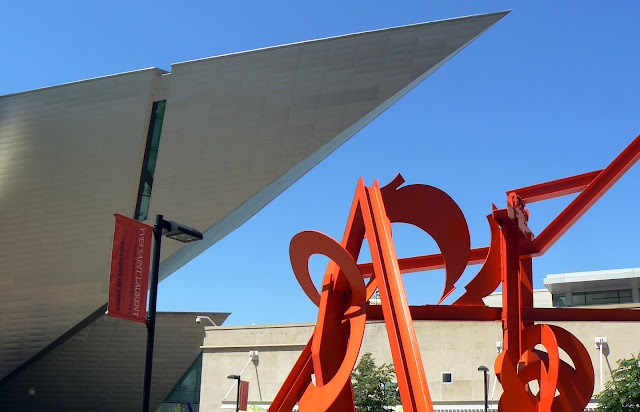Denver Art Museum
The Frederic C. Hamilton building of the Denver Art Museum was the first work of Daniel Libeskind designed in the U.S. The new building stands next to the North Building (designed by Gio Ponti and James Sudler in 1971), and brings contrast to the museum's architectural ensemble.
The Frederic C. Hamilton building evokes an abstract sculpture made of titanium and glass, but as a concrete structure with titanium cladding; none of the 20 planes of the building are parallel to one another.
| Duncan Pavilion |
"Art is a treasure, and these thin but jealous walls defend it," said Gio Ponti аbout The North Building.
 |
| Big Sweep, As To Be In Plain Sight, North Building |
Big Sweep was installed in June of 2006, made by Claes Oldenburg and Coosje van Bruggen. According to the artists, “Riding a free city bus, we glimpsed sanitation workers demonstratively sweeping trash into dustpans as part of a campaign to keep Denver clean. As we talked over lunch, the clear blue sky combined with the characteristic browns of the Denver cityscape to elicit the image of a colossal broom and dustpan, which had appeared in a drawing in that color scheme.”
According to architect's official web-site, the idea of The Hamilton Building’s design recalls the peaks of the Rocky Mountains and geometric rock crystals found in the foothills near Denver.
The project is designed as part of a composition of public spaces, monuments and gateways in this developing part of the city, tying together downtown, the Civic Center, and forming a strong connection to the golden triangle neighborhood. [1]
The materials of the building closely relate to the existing context as well as introducing innovative new materials, such as the 9,000 titanium panels which cover the building’s surface and reflect the brilliant Colorado sunlight. [1]
The public space of the square in front of the museum plays an important role in the socioal function of the city interior. Filled with sculptures, it lets Denver's inhabitants admire art and surrounding architecture, such as the Library Building and the Museum Residences, even not when not inside the museum.
The glass bridge provides a connection with the new Duncan Pavilion, from which visitors can look at the mountains and the Denver skyline.



[1] Studio Daniel Lideskind
denverartmuseum.org














.jpg)

Comments
Post a Comment